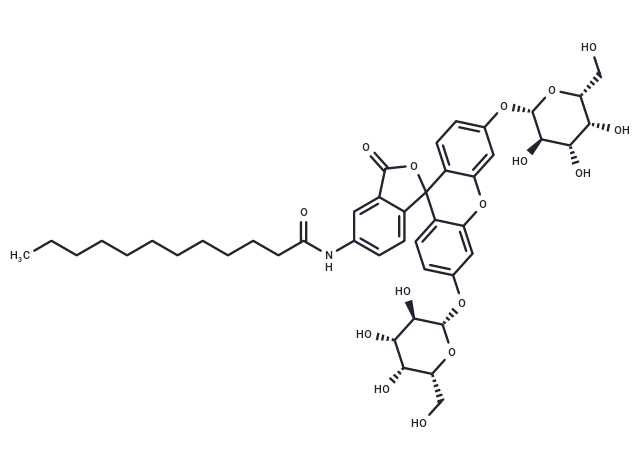Shopping Cart
Remove All Your shopping cart is currently empty
Your shopping cart is currently empty
C12FDG (5-Dodecanoylaminofluorescein di-beta-D-Galactopyranoside) is used as a lipophilic green fluorescent substrate for detecting beta-galactose activity, a green fluorescent substrate, is a senescence marker and is often used in conjunction with flow cytometry.

| Pack Size | Price | USA Warehouse | Global Warehouse | Quantity |
|---|---|---|---|---|
| 1 mg | $163 | In Stock | In Stock | |
| 5 mg | $443 | In Stock | In Stock | |
| 10 mg | $645 | In Stock | In Stock | |
| 25 mg | $1,000 | In Stock | In Stock | |
| 50 mg | $1,350 | In Stock | In Stock | |
| 100 mg | $1,830 | In Stock | In Stock | |
| 200 mg | $2,450 | - | In Stock |
| Description | C12FDG (5-Dodecanoylaminofluorescein di-beta-D-Galactopyranoside) is used as a lipophilic green fluorescent substrate for detecting beta-galactose activity, a green fluorescent substrate, is a senescence marker and is often used in conjunction with flow cytometry. |
| In vitro | Fluorescence aging-related β-galactosidase (SA-β-Gal) assay [1]: 1.Cultivate cells at a density of 10^5 cells/mL. 2.Wash cells once with 200 μL PBS, then fix with 100 μL fixation solution (2% formaldehyde/0.2% glutaraldehyde in1. distilled water) at room temperature for 5 minutes. 3.Wash cells twice with 200 μL PBS, stain with 100 μL 33 μM C12FDG (PBS, pH 6.0) for 10 minutes, then stain with 200 μL Hoechst solution (1 μg/mL Hoechst 33342) in PBS (pH 6.0) for 10 minutes. 4.Image cells using a 20x objective and excitation filters of 360 nm (Hoechst 33342) and 480 nm (C12FDG), monitor cells using emission filters of 460 nm and 535 nm. This protocol is provided for reference and should be modified according to the specific requirements of your experiment. |
| Cell Research | Fluorescence aging-related β-galactosidase (SA-β-Gal) experiment I. Solution preparation: 1. Mother solution preparation: Prepare a certain concentration of C12FDG mother solution, store it at -20℃ or -80℃ in the dark after aliquoting. 2. Working solution preparation: Select the appropriate working solution concentration according to the experimental requirements, and try to prepare it before use. II. Operation steps: 1. Culture cells with a density of 105 cells/mL 2. Wash the cells once with 200 μL PBS, and then fix them with 100 μL fixative (2% formaldehyde/0.2% glutaraldehyde distilled water) at room temperature for 5 minutes. 3. Wash the cells twice with 200 μL PBS, stain with 100 μL 33 μM C12FDG (PBS, pH = 6.0) for 10 min, and then stain with 200 μL Hoechst solution (1 μg/mL Hoechst 33342) in PBS (pH 6.0) for 10 min. d. Image the cells using a 20x objective and excitation filters of 360 nm (Hoechst 33342) and 480 nm (C12FDG), and monitor the cells using emission filters of 460 nm and 535 nm. |
| Synonyms | 5-Dodecanoylaminofluorescein di-β-D-Galactopyranoside |
| Molecular Weight | 853.9 |
| Formula | C44H55NO16 |
| Cas No. | 138777-25-0 |
| Smiles | CCCCCCCCCCCC(=O)Nc1ccc2c(c1)C(=O)OC21c2ccc(O[C@@H]3O[C@H](CO)[C@H](O)[C@H](O)[C@H]3O)cc2Oc2cc(O[C@@H]3O[C@H](CO)[C@H](O)[C@H](O)[C@H]3O)ccc12 |
| Storage | keep away from direct sunlight,keep away from moisture | Powder: -20°C for 3 years | In solvent: -80°C for 1 year | Shipping with blue ice/Shipping at ambient temperature. | |||||||||||||||||||||||||||||||||||
| Solubility Information | DMSO: 150 mg/mL (175.66 mM), Sonication is recommended. | |||||||||||||||||||||||||||||||||||
| In Vivo Formulation | 10% DMSO+40% PEG300+5% Tween-80+45% Saline: 1.5 mg/mL (1.76 mM), Sonication is recommeded. Please add the solvents sequentially, clarifying the solution as much as possible before adding the next one. Dissolve by heating and/or sonication if necessary. Working solution is recommended to be prepared and used immediately. The formulation provided above is for reference purposes only. In vivo formulations may vary and should be modified based on specific experimental conditions. | |||||||||||||||||||||||||||||||||||
Solution Preparation Table | ||||||||||||||||||||||||||||||||||||
DMSO
| ||||||||||||||||||||||||||||||||||||
| Size | Quantity | Unit Price | Amount | Operation |
|---|

Copyright © 2015-2026 TargetMol Chemicals Inc. All Rights Reserved.